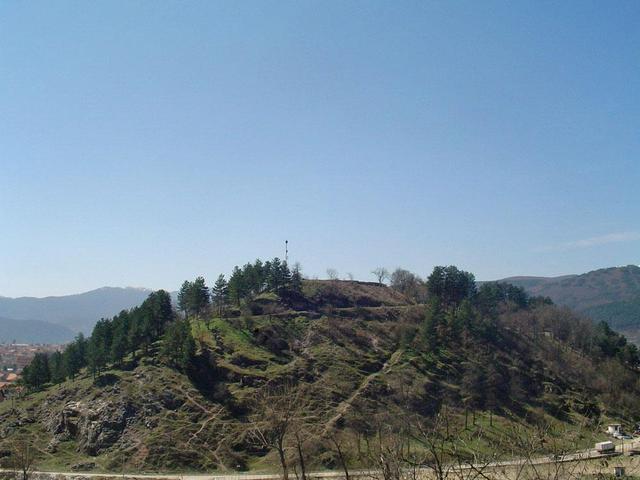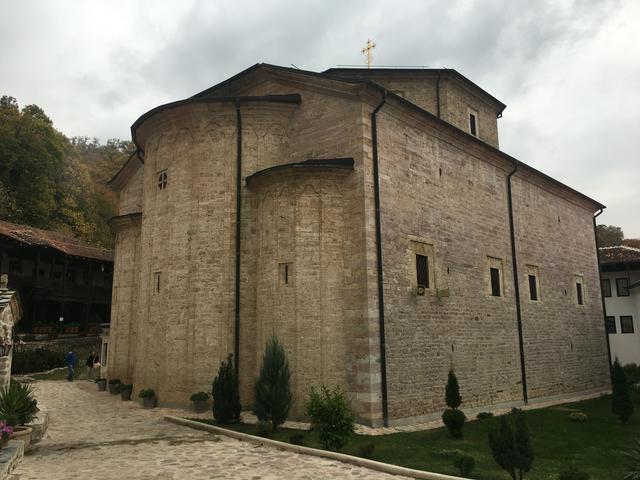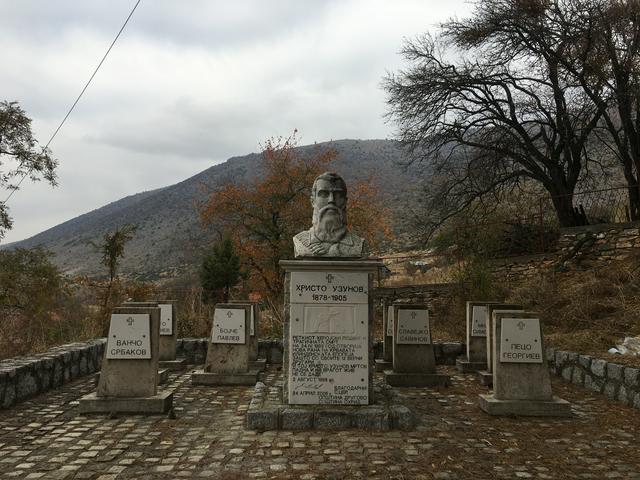Kičevo (Macedonian: Кичево, Albanian: Kërçovë) is a city in western North Macedonia.
Kičevo is situated in a valley on the southeastern slopes of Mount Bistra in the central western part of the country. The city has roughly 27,000 residents, while the municipality as a whole has over 56,000 residents. The largest ethnic group in the city is the ethnic Macedonians, with a large Albanian minority. There are also sizable minorities of Turks and Roma (Gypsies).
Kičevo contains some of the historical Železnik region, primarily within neighboring Demir Hisar today. It also contains the entirety of the historical Kopčka region. Both are dotted with traditional Macedonian villages.
On 11 September 1943, during World War II, Kičevo became the first city in Macedonia to be liberated by the partisans.



- Kitino Kale. Kičevo's fortress ruins. Located on a prominent hill in the city center, not much remains of the fortress and the area is now a park. It dates to the Bronze and Iron ages and was used until around 1850 during Ottoman rule when it ceased to be used by authorities and locals were allowed to use the stone from the fortress to build buildings elsewhere. Its elevated location provides a good view above the city. There is also a memorial ossuary on Kitino Kale as well as other small monuments.
- Museum of Western Macedonia in the National Liberation War, Blvd Osloboduvanje. This museum showcases the history of western Macedonia in the 19th century, the Ilinden Uprising, and the National Liberation War of World War II. It opened in 1980 in a historic building dating from 1892 that was used by partisans in the National Liberation War. The collection includes authentic weapons, flags, and more.
- Church of Sts Peter and Paul. The main church of the city, Sts Peter and Paul was built in 1907 atop foundations of an older church. The front of the church has a prominent bell tower.
Following a merger with three neighboring municipalities, Kičevo has a total of 79 villages. The former Drugovo Municipality, now the southwest portion of Kičevo Municipality, has a large concentration of old villages with traditional Macedonian architecture.
- Kičevo Monastery, village of Manastirsko Dolenci, 10 km south of Kičevo. This monastery, dedicated to the Immaculate Mother of God (Sveta Bogorodica Prečista), was established in 1316, though most of the present monastery dates to the 19th century. One of the best-known sites of Kičevo, it is the spiritual center of this region and a notable Macedonian monastery. Within the village of Manastirsko Dolenci, it is situated on Cocan Mountain. The icons of the church were done by noted painter Dičo Zograf in the mid-1800s. The annual feast day for the Holy Mother on September 21 draws many visitors to the monastery. Aside from the main church, there is also a smaller church dedicated to St Nicholas.
- Knežino Monastery, village of Knežino. This monastery complex, on Mount Bistra, dates to the 11th or 12th centuries, evidenced by ruins on the site today. Dedicated to St George, the original monastery caught fire in the 18th century and was soon abandoned. It wasn't until 1973 that it was brought back to life and construction of a new monastery began. The main church was completed in 2007. The grounds also contain two water sources which are said to having healing properties.
- Church of St Nicholas, village of Cer. One of the more historically significant villages of this area, Cer has one of the more impressive churches. Dedicated to St Nicholas, it was built in the mid-19th century and its iconostasis was done in 1839. Its yard contains a bell tower and the village cemetery.
- Church of St George, village of Belica. Belica is a village with much traditional Macedonian architecture. Its main church was built in 1867 and its contains icons done by noted painter Dičo Zograf of the Debar school. The church was renovated in celebration of its 150th anniversary.
- Church of St George, village of Lazarovci. This church was built in the late 16th or early 17th century. Noted for its frescoes which date from its construction, the small church sits above the village and has a tall bell tower on its grounds as well as the village cemetery.
- Church of St George, village of Malo Crsko. St George is the main church of Malo Crsko, situated between it and Golemo Crsko. It was built in 1848 of stone and is among the larger churches in the area. The village also has a small, charming church dedicated to St Nedela in the forest outside the village.
- Church of St Athanasius, village of Judovo. This main church of the village was constructed in 1845 and its frescoes were completed in 1902. The charming small church had its icons done by an artist from Lazaropole, noted for its religious artists.
- Church of the Virgin Mary, village of Klenoec. The main church of the mountain village of Klenoec is dedicated to the Virgin Mary and built in the 19th century. It is among the larger churches of the area and its iconostasis was done in 1913. The church yard also contains a tall cross and a bell tower, easily accessible and providing views of the surroundings from its top. Also notable in Klenoec is its monument to the National Liberation War. Many villages have a monument dedicated to this, however Klenoec's has a unique design.
Kičevo Monastery, village of Manastirsko Dolenci, 10 km south of Kičevo. This monastery, dedicated to the Immaculate Mother of God (Sveta Bogorodica Prečista), was established in 1316, though most of the present monastery dates to the 19th century. One of the best-known sites of Kičevo, it is the spiritual center of this region and a notable Macedonian monastery. Within the village of Manastirsko Dolenci, it is situated on Cocan Mountain. The icons of the church were done by noted painter Dičo Zograf in the mid-1800s. The annual feast day for the Holy Mother on September 21 draws many visitors to the monastery. Aside from the main church, there is also a smaller church dedicated to St Nicholas.
Knežino Monastery, village of Knežino. This monastery complex, on Mount Bistra, dates to the 11th or 12th centuries, evidenced by ruins on the site today. Dedicated to St George, the original monastery caught fire in the 18th century and was soon abandoned. It wasn't until 1973 that it was brought back to life and construction of a new monastery began. The main church was completed in 2007. The grounds also contain two water sources which are said to having healing properties.
Church of St Nicholas, village of Cer. One of the more historically significant villages of this area, Cer has one of the more impressive churches. Dedicated to St Nicholas, it was built in the mid-19th century and its iconostasis was done in 1839. Its yard contains a bell tower and the village cemetery.
Church of St George, village of Belica. Belica is a village with much traditional Macedonian architecture. Its main church was built in 1867 and its contains icons done by noted painter Dičo Zograf of the Debar school. The church was renovated in celebration of its 150th anniversary.
Church of St George, village of Lazarovci. This church was built in the late 16th or early 17th century. Noted for its frescoes which date from its construction, the small church sits above the village and has a tall bell tower on its grounds as well as the village cemetery.
Church of St George, village of Malo Crsko. St George is the main church of Malo Crsko, situated between it and Golemo Crsko. It was built in 1848 of stone and is among the larger churches in the area. The village also has a small, charming church dedicated to St Nedela in the forest outside the village.
Church of St Athanasius, village of Judovo. This main church of the village was constructed in 1845 and its frescoes were completed in 1902. The charming small church had its icons done by an artist from Lazaropole, noted for its religious artists.
Church of the Virgin Mary, village of Klenoec. The main church of the mountain village of Klenoec is dedicated to the Virgin Mary and built in the 19th century. It is among the larger churches of the area and its iconostasis was done in 1913. The church yard also contains a tall cross and a bell tower, easily accessible and providing views of the surroundings from its top. Also notable in Klenoec is its monument to the National Liberation War. Many villages have a monument dedicated to this, however Klenoec's has a unique design.
- Hristo Uzunov Memorial, village of Cer. On 24 April 1905, Hristo Uzunov and his band of rebels, after a long and uneven battle against the Ottomans, took their own lives in the village of Cer so as not to be captured alive. A memorial containing the remains of the revolutionaries was erected on the exact site. There is a church dedicated to St Athanasius nearby, built in 1863.
- Old School Building, village of Podvis. The first classes in the newly-standardized Macedonian language were held in Podvis on 23 September 1943, just ten days after the area was liberated in World War II. The school building today, however, sits in ruins in the largely depopulated village.
Hristo Uzunov Memorial, village of Cer. On 24 April 1905, Hristo Uzunov and his band of rebels, after a long and uneven battle against the Ottomans, took their own lives in the village of Cer so as not to be captured alive. A memorial containing the remains of the revolutionaries was erected on the exact site. There is a church dedicated to St Athanasius nearby, built in 1863.
Old School Building, village of Podvis. The first classes in the newly-standardized Macedonian language were held in Podvis on 23 September 1943, just ten days after the area was liberated in World War II. The school building today, however, sits in ruins in the largely depopulated village.
Kitino Kale. Kičevo's fortress ruins. Located on a prominent hill in the city center, not much remains of the fortress and the area is now a park. It dates to the Bronze and Iron ages and was used until around 1850 during Ottoman rule when it ceased to be used by authorities and locals were allowed to use the stone from the fortress to build buildings elsewhere. Its elevated location provides a good view above the city. There is also a memorial ossuary on Kitino Kale as well as other small monuments.
Museum of Western Macedonia in the National Liberation War, Blvd Osloboduvanje. This museum showcases the history of western Macedonia in the 19th century, the Ilinden Uprising, and the National Liberation War of World War II. It opened in 1980 in a historic building dating from 1892 that was used by partisans in the National Liberation War. The collection includes authentic weapons, flags, and more.
Church of Sts Peter and Paul. The main church of the city, Sts Peter and Paul was built in 1907 atop foundations of an older church. The front of the church has a prominent bell tower.
- Bitola. — one of the most European-flavoured cities in the country, Bitola is known for its colourful neo-classical architecture and the Ancient Macedon ruins of Heraclea Lyncestis nearby
- Brajčino.
- Debar.
- Demir Hisar.
- Galičica National Park. Between Ohrid and Prespa Lakes
- Gostivar.
- Mavrovo National Park.
- Kruševo.
- Makedonski Brod.
- Ohrid. — with ancient churches and flower-filled balconies in the hillside old city, and beach life down below on the lake coast, this is no doubt the "Macedonian Riviera"
- Pelister National Park. located in the Baba Mountain massif, near to Bitola
- Prilep.
- Resen.
- Struga. — on the northern shore of the lake, Struga is a smaller, quiter, cheaper, but less fun alternative to Ohrid
- Tetovo. — unofficial capital of the Albanians of Macedonia, Tetovo is the site of the one of the most unique mosques in the world, the Painted Mosque
- Vevčani.
Bitola. — one of the most European-flavoured cities in the country, Bitola is known for its colourful neo-classical architecture and the Ancient Macedon ruins of Heraclea Lyncestis nearby
Brajčino.
Debar.
Demir Hisar.
Galičica National Park. Between Ohrid and Prespa Lakes
Gostivar.
Mavrovo National Park.
Kruševo.
Makedonski Brod.
Ohrid. — with ancient churches and flower-filled balconies in the hillside old city, and beach life down below on the lake coast, this is no doubt the "Macedonian Riviera"
Pelister National Park. located in the Baba Mountain massif, near to Bitola
Prilep.
Resen.
Struga. — on the northern shore of the lake, Struga is a smaller, quiter, cheaper, but less fun alternative to Ohrid
Tetovo. — unofficial capital of the Albanians of Macedonia, Tetovo is the site of the one of the most unique mosques in the world, the Painted Mosque
Vevčani.
